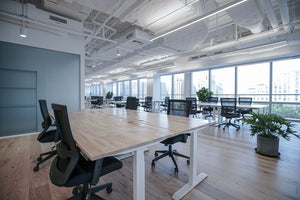Introduction
Welcome to our comprehensive guide on selecting the right used office furniture. Whether you're outfitting a small home office or looking to furnish a larger workspace on a budget, choosing used furniture can be a smart, sustainable, and cost-effective solution. In this guide, we'll walk you through everything you need to know to make informed choices, from assessing the quality and durability of pieces to understanding the importance of ergonomics and space optimization.
Why Choose Used Office Furniture?
Environmental Benefits: Opting for used furniture is an eco-friendly choice. It reduces waste and conserves resources, helping you contribute to a more sustainable planet.
Cost Savings: One of the most compelling reasons to choose used office furniture is the cost advantage. You can often find high-quality pieces at a fraction of the cost of new furniture, allowing you to furnish your office stylishly without breaking the bank.
Unique Finds: Used furniture can offer unique styles and designs that may no longer be available new, adding character and uniqueness to your workspace.
Assessing Furniture Quality
Durability Check: Start by inspecting the furniture for signs of durability. Check for sturdy construction, solid joints, and the absence of major damage. Minor scratches or wear can be acceptable, but avoid pieces with structural weaknesses.
Material Matters: Understand the materials used in the furniture. Solid wood, metal, and high-grade plastic tend to last longer. Look for signs of quality craftsmanship, such as even finishes and smooth edges.
Previous Usage: Inquire about the history of the furniture. Items from low-traffic areas or lightly used spaces are often in better condition.
Ergonomics: Comfort and Productivity
Importance of Ergonomics: Ergonomic furniture is designed to support your body comfortably and reduce strain during long working hours. It can significantly boost comfort and productivity.
Choosing Ergonomic Chairs: Look for chairs with adjustable height, lumbar support, and comfortable cushioning. Ensure that the chair can be adjusted to your body size and workspace needs.
Desks and Workstations: Select desks with appropriate height and space. Consider adjustable or standing desks as ergonomic options that offer flexibility.
Space Optimization
Maximizing Small Spaces: For smaller offices, choose furniture that is proportional to your space. Consider pieces with storage options or those that can be easily moved or reconfigured.
Multi-functional Furniture: Opt for furniture that can serve multiple purposes. For example, a storage cabinet that can double as a printer stand or a desk with built-in shelving can be excellent space savers.
Planning Your Layout: Before purchasing, plan your office layout. Measure your space and consider how each piece of furniture will fit and contribute to a functional and comfortable workflow.
Aesthetic Considerations
Style and Design: While functionality is key, the aesthetic appeal of your office shouldn’t be overlooked. Choose pieces that reflect your personal style or your company's brand.
Coordinating Pieces: Try to maintain a cohesive look. If you can’t find matching sets, look for pieces in complementary styles or colors.
The Power of Aesthetics: Remember that a well-designed office can boost morale and create a pleasant working environment. Used furniture can offer unique, stylish options that new furniture sometimes can't match.
Safety and Compliance
Checking for Compliance: Ensure the furniture meets safety standards. Look for labels or certifications indicating compliance with industry regulations.
Stability and Safety: Test the stability of desks, chairs, and shelves. Avoid items that are wobbly or have loose components, as these can be safety hazards.
Fire Safety: Particularly for upholstered items, check for fire safety labels. Furniture used in commercial spaces often needs to meet stricter fire safety standards.
Maintenance and Upkeep
Cleaning and Care: Learn about the proper care for different materials. Wood may require polish, while metal might need rust protection.
DIY Repairs: Simple DIY solutions can fix minor issues, like tightening loose screws or applying a fresh coat of paint.
Protecting Your Investment: Regular maintenance extends the life of your furniture. Use coasters, desk pads, and other protective items to keep surfaces in good condition.
Where to Find Quality Used Office Furniture
Online Marketplaces: Websites like eBay, Craigslist, and specialized office furniture sites can be great sources. Read descriptions carefully and check seller ratings.
Local Thrift Stores and Flea Markets: These can be goldmines for unique finds. Visit regularly, as inventory changes frequently.
Office Liquidation Sales: Businesses closing or renovating often sell their furniture at reduced prices. This can be a great opportunity to find quality items.
Checklist: Summary of Key Points
- Quality Check: Ensure durability, stability, and material quality.
- Ergonomics: Choose adjustable, body-supporting chairs and desks.
- Space Efficiency: Opt for furniture that fits your space and offers storage solutions.
- Aesthetics: Select pieces that align with your style and office decor.
- Safety Standards: Verify compliance with safety and fire regulations.
- Maintenance: Commit to regular cleaning and upkeep.
- Shopping Sources: Explore various sources like online platforms, thrift stores, and liquidation sales.
Conclusion
Choosing the right used office furniture requires a balance of quality, ergonomics, aesthetics, and practicality. By considering the points outlined in this guide, you can create a workspace that is both functional and inviting. Not only will you save money, but you'll also be making an environmentally responsible choice. With a bit of patience and careful selection, you can find pieces that will serve you well for years to come.

































































































